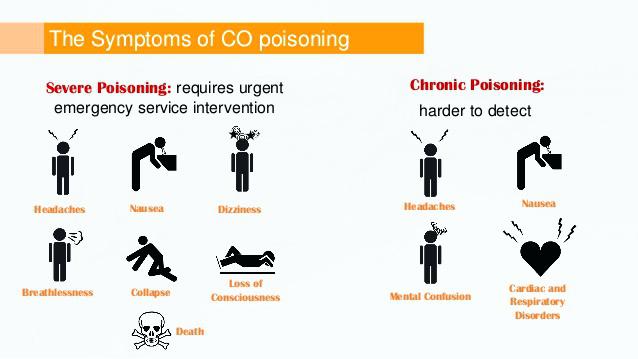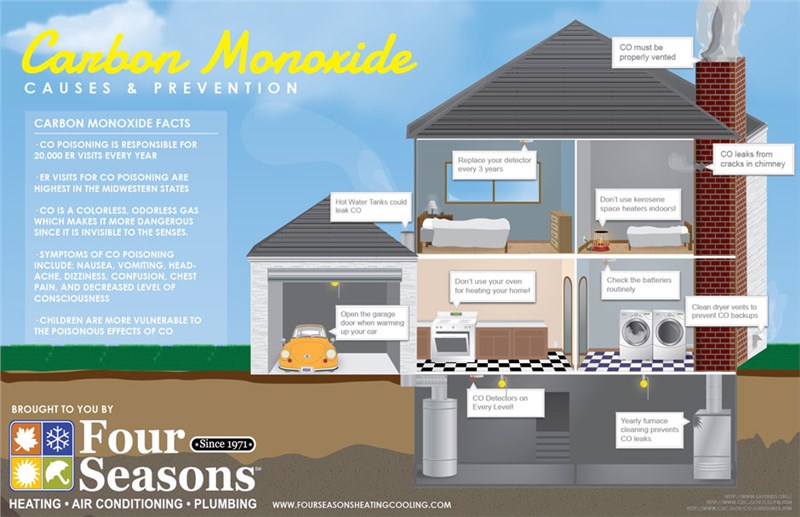Table Of Content

Populations at the greatest risk include the very young, the elderly and people with heart disease, asthma and other underlying conditions. “Even a very healthy person can die if they are exposed to enough CO,” Smeltzer says. The most common symptoms of carbon monoxide poisoning are vague and related to many conditions. Without a CO detector, it's unlikely you'll notice a CO leak until it's too late. That's why it's important to have CO detectors in your home that can identify low levels of carbon monoxide before it becomes dangerous. Symptoms of carbon monoxide poisoning include headaches, dizziness, weakness, vomiting, chest pain, and confusion.
Nausea or vomiting
Brain death can occur in as little as 10 minutes, according to the Cleveland Clinic. Again, because symptoms are so interchangeable, Smeltzer says CO detectors are the way to go. When installing CO detectors in your home, at the very least, place one outside of each bedroom.
Kitchen and Household Guides

People who are sleeping or drunk can die from CO poisoning before they have symptoms. For possible carbon monoxide poisoning, get into fresh air and seek medical care right away. If your carbon monoxide detector goes off, get everyone outdoors and call your gas company’s emergency line or 911. Stay outdoors until professionals tell you it’s safe to reenter. A carbon monoxide detector will alert you if there are any dangerous gasses in your home. However, it’s best to avoid using appliances that generate CO and to take all necessary precautions.
Carbon Monoxide (CO) Poisoning Prevention
If CO poisoning has occurred, it can often be diagnosed by a blood test done soon after exposure. You should go to the hospital right away if you’ve been exposed to a source of CO, even if you don’t show symptoms of CO poisoning. Everyone is exposed to small amounts of carbon monoxide throughout the day. Have a qualified technician inspect and maintain your heating systems, including furnaces, boilers, and chimneys, to ensure proper ventilation and safe operation. If your heating system isn’t working correctly, it can produce CO.
What does carbon monoxide poisoning feel like, and how to treat it
But don’t rely on symptoms alone — CO can kill with no warning. That’s why it’s “very important to have working CO alarms in the home,” Smeltzer says. These systems change the level of moisture, dust, and germs in your home. Make sure yours is properly installed and serviced, and change filters regularly. You can even try a special HEPA filter that removes smaller particles from the air in your house.
Analysis Why a carbon monoxide monitor in your home may not be enough to protect you - The Washington Post
Analysis Why a carbon monoxide monitor in your home may not be enough to protect you.
Posted: Mon, 12 Feb 2018 08:00:00 GMT [source]
You can’t see or smell carbon monoxide, but at high levels it can kill a person in minutes. Carbon monoxide (CO) is produced whenever any fuel such as gas, oil, kerosene, wood, or charcoal is burned. If appliances that burn fuel are maintained and used properly, the amount of CO produced is usually not hazardous. However, if appliances are not working properly or are used incorrectly, dangerous levels of CO can result. Hundreds of people die accidentally every year from CO poisoning caused by malfunctioning or improperly used fuel-burning appliances. Fetuses, infants, elderly people, and people with anemia or with a history of heart or respiratory disease can be especially susceptible.
People and animals in these spaces can be poisoned and can die from breathing CO. Fuels include wood, gasoline, coal, natural gas, or kerosene. Breathing in carbon monoxide fumes prevents the body from using oxygen properly, which can harm the brain, heart, and other organs.
Common Causes of Carbon Monoxide in Homes
It is important, therefore, to advise the ER doctor of your suspicions if you believe CO is involved. Excessive exposure to CO can lead to severe heartbeat irregularities, seizures, unconsciousness, and even death. And yet, every year, more than 400 people in the U.S. die and tens of thousands more are sickened. CO poisoning can cause severe brain damage, and it may cause a progressive worsening of memory and concentration.
This can occur if there is a blockage in the chimney or flue or if the furnace doesn’t vent correctly. Carbon monoxide is also harmful when inhaled because it reduces the amount of oxygen blood can transport throughout the body, which can lead to poisoning. It can trap dust, mold, dust mites, dirt, and other irritants. When you clean it or walk on it, those particles can get into the air. The chemicals used to make and install some carpeting could be bad for you, too.
Common household items — such as gas fires, oil-burning furnaces, portable generators, and charcoal grills — put people at risk of exposure to this poison gas. Your doctor may temporarily place you in a pressurized oxygen chamber (also known as a hyperbaric oxygen chamber). This treatment quickly increases oxygen levels in the blood and it’s typically used in severe cases of CO poisoning or to treat CO poisoning in pregnant women. Carbon monoxide build-up is not necessarily a result of a malfunctioning appliance. When the gas concentrates in a small area and cannot dissipate, people and animals can get poisoned.
Most people with a mild exposure to carbon monoxide experience headaches, fatigue, and nausea. Unfortunately, the symptoms are easily overlooked because they are often flu-like. Never try to patch a vent pipe with tape or gum or anything else. Don't use a portable gas camp stove or portable flameless chemical heaters indoors.

(Check your state regulations.) “It isn’t a bad idea to have one on every level,” Smeltzer says. Nonspecific symptoms like fatigue can make CO poisoning a difficult public health issue to deal with, Smeltzer says. “A lot of times people will assume that they are sick from a virus, when it is actually a CO problem in their indoor environment,” she says. “Exposure to high levels can lead to death, but even low levels of CO exposure can impact the health of sensitive individuals,” Smeltzer says. Smeltzer says hospital data shows a clear spike in CO poisoning cases during times of high generator use, like after natural disasters. Humidity above 50% may invite bacteria, fungi, and other germs.
Carbon Monoxide Poisoning: Symptoms, Treatment, & More - Health.com
Carbon Monoxide Poisoning: Symptoms, Treatment, & More.
Posted: Fri, 24 Mar 2023 07:00:00 GMT [source]
People with health problems, such as heart and lung disease, are at greater risk for harm. Infants, children, pregnant women, and older adults are also at greater risk. Symptoms of carbon monoxide poisoning are often described as flu-like, including headache, nausea, vomiting, chest pain, dizziness, weakness and confusion. A person who's sleeping is unlikely to register these symptoms and can easily die in their sleep.
Another way carbon monoxide disrupts the body’s systems is by diminishing the oxygen storage in muscle cells by binding to and displacing oxygen from myoglobin. If you detect any signs of carbon monoxide in your house or think you have been exposed, contact your local utility provider or call 911 immediately. Natural gas leaks are the primary source of carbon monoxide in most homes.

No comments:
Post a Comment